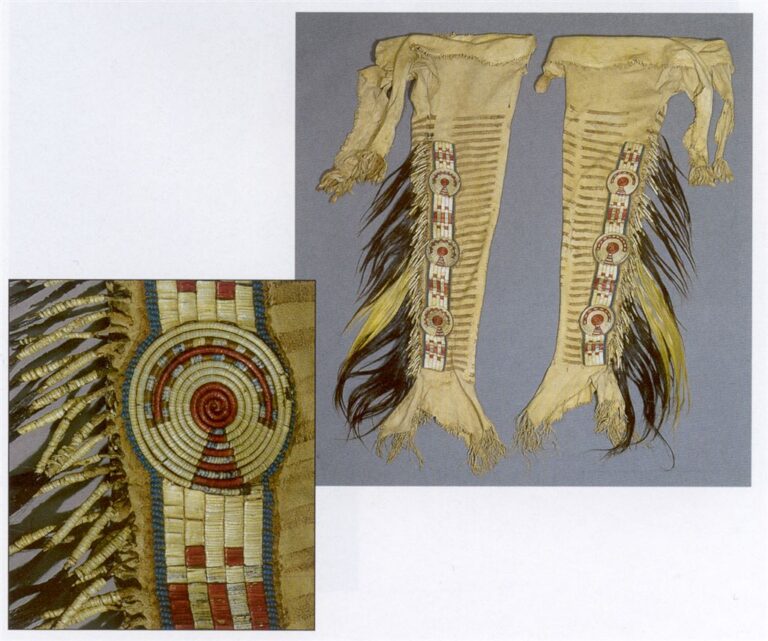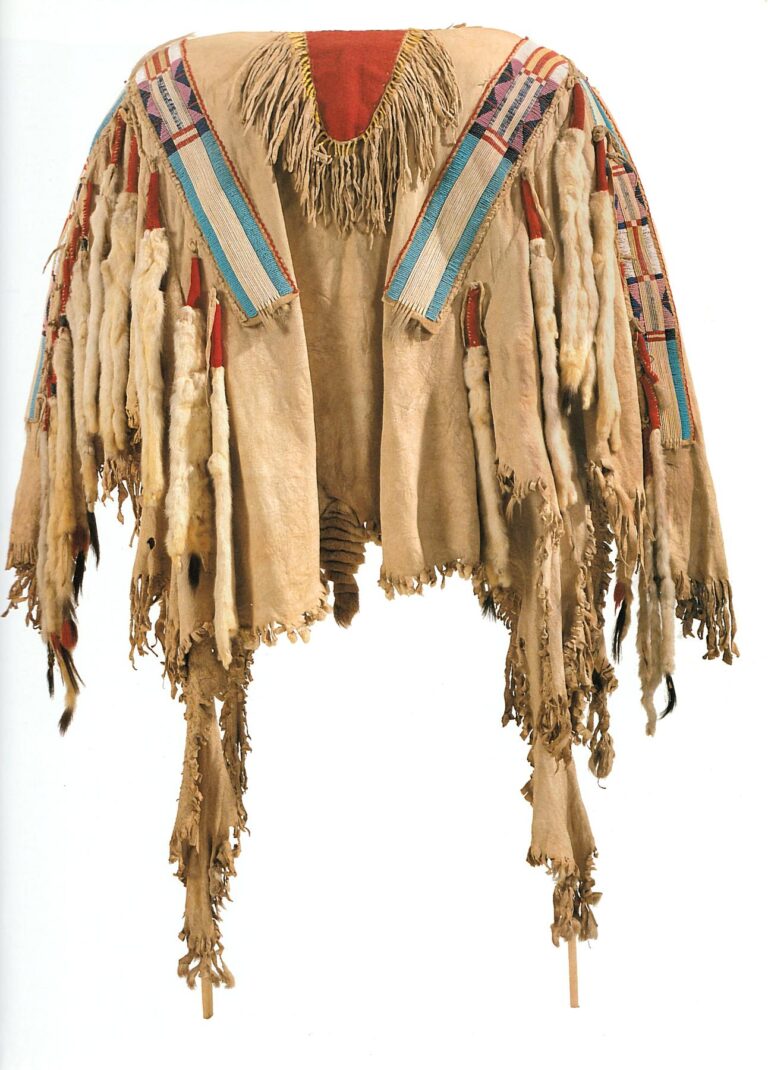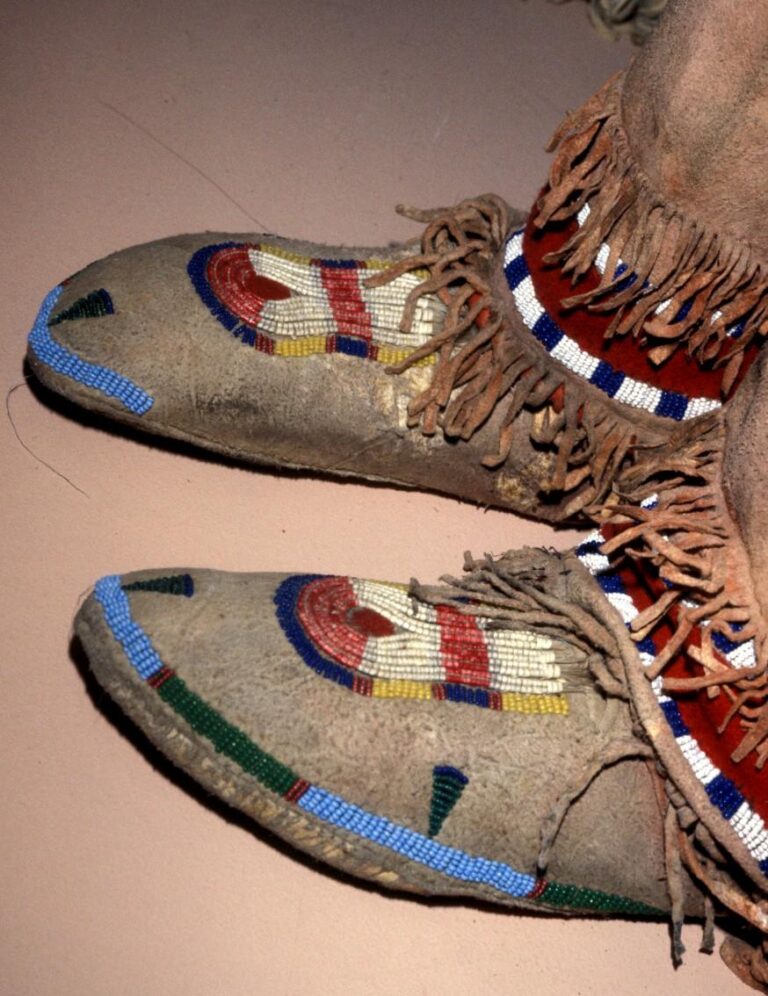The quill-wrapped horsehair (QWHH) technique is one of the most exacting and fascinating quillwork techniques ever. It involves using thin bundles of horsehair as a filler and wrapping porcupine quills around them while sewing them onto a buckskin base at the same time.
It differs from other quillwork techniques in that it is three-dimensional, creating a spatial effect.

Time and area of distribution
How and where this technique originated is not entirely clear, but it was likely widespread among the Crow tribe and also in the Plateau region (the Nez Percés, Wishram, Cayuse, Yakima, Walla Walla and other tribes), as most of the extant originals were collected there. Culturally, the horsehair wrapping technique can be classified as a part of the “Transmontane style”.
It is certainly an old technique, the earliest pieces having been collected as early as the 1830s, but it did not completely disappear even later, although it does not seem to have been as common in the second half of the 19th century as in the first half.
The difficulty
Technically speaking, it is one of the most, if not the most, difficult of all quillwork techniques, and only the most skilled quillworkers are able to learn and master it. The difficulty lies in the fact that one has to work simultaneously with the base leather, the thread, the porcupine quills and also the bundles of horsehair, which must be kept at the required strength, which is not easy.

The work is not only difficult but also progresses very slowly. It takes many times longer to embroider a given area than with conventional, “two-dimensional” techniques.
The complexity and time-consuming nature of this technique, and the fact that there are very few artists who have mastered it, makes it very expensive.

The variants
There are two variants of this technique, which differ in whether the quills are wrapped around one or two horsehair fillings.
The single-bundle variant
Only one bundle of horsehair was used as a filler, creating one single tube. The quills were wrapped around it and sewn to the leather base at the same time. This variation was used to create rosettes exclusively, starting at the center and continuing outwards in a spiral. Interestingly, most of the rosettes were coiled anticlockwise.
The double-bundle variant
It was used mostly to cover straight areas, as in the case of a war shirt or leggings strips. Two bundles of horsehair were employed in this variation. The quills were placed over the two separate horsehair bundles, lying side by side and sewn onto the leather base at the sides and also between the two bundles, creating a double-hill effect. Several of those double-bundle lanes were usually connected together to cover larger areas.


The use of the quill-wrapped horsehair technique
This technique was most often used to decorate garments such as war shirts or leggings strips or even some coats and moccasins. I also know of one specimen of a quiver and one medicine bag made of otter fur, both decorated with QWHH rosettes.
The extant originals
The artifacts with QWHH embroideries are very rare, with no more than a few dozen surviving pieces scattered around the world in museums or private collections.
Buffalo robe strips
Only very few have survived; I know of 14 pieces in total (some of which are just torsos) and two separate rosettes. They can be divided into two categories. All the strips have rosettes embroidered using the QWHH technique, but they differ in the way the rectangular panels are embroidered.
The strips in the first category have rectangular parts embroidered with porcupine quills, either using the QWHH technique (two complete pieces and one torso) or the multiple-plaited quillwork (three complete pieces). The strips of the second category have rectangular panels embroidered with seed beads in the classic Transmontane style (eight pieces).

War shirts
Just over 20 examples of war shirts with quill-wrapped horsehair strips have survived. They can again be divided into several categories. The first category includes war shirts that have all four bands embroidered with QWHH technique (in all cases with the typical double-bundle variant), then war shirts that have only two strips embroidered in this technique, while the other two strips are embroidered with the multiple quillwork.
There are also some war shirts that are decorated only with QWHH rosettes, but whose strips are embroidered using a different technique.
Leggings
In total, I am currently aware of seven examples of leggings whose strips incorporate the QWHH technique. Four of these have straight rectangle strips embroidered with several rows of QWHH double bundle technique and three with the strips embroidered with a combination of rosettes and long rectangle panels. All of these rosettes are done with single bundle QWHH, while the rectangular panels are embroidered with a different quillwork technique, usually the multiple quillwork.
Virtually all of these leggings are of the oldest type, i.e., bottom tab leggings.


Moccasins
There are also a few surviving moccasins decorated with the QWHH technique, slightly more than 10 pieces. They are of both types: side seam moccasins and two-piece hard sole moccasins. Most are embroidered with the so-called keyhole design, a form of embroidery consisting of a round rosette and an adjoining trapezoid, resembling the shape of a keyhole.
In this type of decoration, the rosette is often embroidered using the single-bundle QWHH technique, while the trapezoid part is embroidered using a different technique. However, some keyholes are embroidered entirely with the QWHH technique. In this case, the rosette is embroidered with a double bundle technique that bends to create both the rounded and the straight part of the embroidery.
Other artifacts
Other unique artifacts bearing this remarkable technique include a quiver, now in the collections of the National Museum of Natural History in Washington DC. It was reportedly collected by the famous painter George Catlin from the Crow Indians. The quiver is of one-piece construction and is decorated with four single-bundle rosettes. The rosettes are also beaded with pony beads. In addition to the rosettes, the quiver is decorated with other quillwork techniques.
A certain anomaly is a medicine bag, made of the fur of an otter, which was obtained from the Oto tribe of the Eastern prairies. The bag contains a single rosette embroidered with single-bundle QWHH, sewn to the root of the otter’s tail. However, I do not believe that this is a rosette made by this tribe, but that it was rather obtained by trade or as loot and sewn onto the bag afterwards.





















